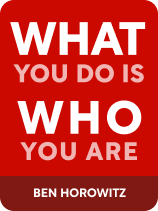

This article is an excerpt from the Shortform book guide to "What You Do Is Who You Are" by Ben Horowitz. Shortform has the world's best summaries and analyses of books you should be reading.
Like this article? Sign up for a free trial here .
What’s an intentional culture? What can you learn from historical cultures to apply to your own workplace?
Ben Horowitz’s What You Do Is Who You Are argues that culture is the way employees make decisions and act based on their perception of underlying premises and shared beliefs. Culture derives from what leaders state explicitly and also what they enforce implicitly by example and through the organization’s incentive structure. Leaders’ actions and messaging inform employees’ behavior. Therefore, Horowitz argues that it’s important to be intentional about the culture you’re designing. If you’re not intentional in shaping your culture, your employees will shape it in ways you might not like.
Keep reading for an overview of the book What You Do Is Who You Are.
What You Do Is Who You Are—Book Overview
Ben Horowitz’s What You Do Is Who You Are cites four unique historical cultures to show how to translate your beliefs into action—that is, how to create the culture you want and sustain it over time. In addition, we consider how Horowitz’s advice compares to that of other culture experts and how the real-life business examples he shares measure up in the years after publication.
(Shortform note: Experts argue that, if a strong cultural identity flows down from the top, it’s easier to get the entire company aligned. If not, siloed departments each start creating their own competing cultures, and there is no coherent identity binding the organization together.)
Why Culture Matters
Horowitz cites three reasons leaders should care about culture. First, an intentional culture serves the company’s vision by ensuring employees know what to do to move the company forward and consistently do it. (Shortform note: In Built to Last, Jim Collins and Jerry Porras argue that culture helps leaders ensure every element of the business reinforces the others, instead of competing.)
Second, the right culture boosts performance by giving employees a sense of purpose. (Shortform note: In Measure What Matters, John Doerr says culture is, most of all, a shared sense of purpose, and a cohesive company culture where everyone understands their purpose helps employees make decisions quickly and reliably.)
Finally, Horowitz says a great culture plus a great product or service is powerful—it can disrupt an industry and an entire system. If an organization develops effective new behaviors to deal with challenges, and the company is successful, other companies copy the culture in the hopes of being equally successful.
(Shortform note: One of Horowitz’s examples of a great culture plus a great product disrupting an industry is hip-hop. But while hip-hop culture disrupted the music world, its influence extended even further. It also disrupted the way companies in other industries did business. For example, executives at Cristal, a champagne brand hip-hop artists showcased in their music videos, openly rejected a connection to that community. Hip-hop artists responded by no longer using the brand in their videos, and Cristal’s market share dropped dramatically.)
Core Elements of Intentional Cultures
Horowitz says all intentional cultures share two core elements. First, the culture you design should reflect who you are as a leader, your strengths, and beliefs, rather than emulate what other leaders do. If you start from your strengths, the culture you design will be sustainable because you’ll be implementing a style that comes naturally to you. However, your culture shouldn’t reflect your weaknesses, or characteristics that won’t serve the organization’s vision. As the leader, your example sets the tone for the organization, so your weaknesses can permeate the culture as employees emulate your behavior. To keep them from infecting your culture, the author says you first need to become aware of your weaknesses, then immunize your culture against them by building in checks and balances.
(Shortform note: Experts argue that the founder is 80% of a company’s culture. The qualities and strengths that set the founder apart become competitive advantages for the company, but only if the founder builds them into the culture. Also, being aware of your weaknesses is essential in those first rounds of hiring. If the founder has certain weaknesses, she needs to hire people who can complement them with the strengths she’s lacking.)
The second core element of a successful culture is that it supports the organization’s strategy. Horowitz says your cultural features, such as policies, must encourage employees to act in ways that bring the company closer to its vision. (Shortform note: If you’re looking to change your organization’s existing culture, making sure the new culture supports your strategy is key. Experts who studied the cultures of top-performing companies identified matching culture to strategy as the number one principle to follow.)
Lessons From the Samurai Honor Code—Develop Virtues
Horowitz examines four successful cultures in history for lessons that business leaders can apply to developing their own cultures. The first is the samurai culture, which illustrates the importance of establishing clear, actionable values, or virtues.
The samurai were a military class that ruled pre-modern Japan from 1186 until 1868. Their virtues, expressed in an honor code or bushido, were so effective that they kept the samurai in power for nearly 700 years, and they’re still echoed in modern-day Japan. (Shortform note: In The Book of Five Rings, written in the 17th century, samurai warrior Miyamoto Musashi reflects on bushido, “the way of the warrior,” emphasizing the importance of constant practice, achieving mental and physical equilibrium, and ways to defeat any enemy.)
Choose Your Virtues With Action in Mind
From the samurai, Horowitz identifies two characteristics a virtue should have to be effective:
1) Effective virtues are practical and set you up for success. To create an effective virtue, Horowitz says you should specify what the belief would look like in practice, so you can determine whether it’s a virtue you can live up to. If you’d have a hard time applying the virtue consistently, it doesn’t belong in your culture, because you’ll constantly fall short. (Shortform note: In Dare to Lead, Brené Brown shares advice on how to make sure you regularly practice your values (virtues). She suggests listing behaviors that support the belief and regularly assessing whether you’re putting them into practice)
2) Effective virtues define who you are as an organization. You shouldn’t select virtues all other organizations in your industry are already espousing. Horowitz warns that industry cultural standards might not work for you, or you might adopt a cultural practice without adopting the belief underpinning it. (Shortform note: One way to choose virtues that define your organization is to identify the ones your star employees already have. In Traction, Gino Wickman suggests a way to determine your organization’s core values. First, identify your star performers. Then list the characteristics they embody, and decide which of those values define your company.)
Explain How to Apply Virtues
Effective virtues have detailed definitions, instructions, and examples. Horowitz explains that bushido defined what each virtue was and what it wasn’t, and it explained what they looked like in action. The virtues complemented each other, preventing warriors from narrowly pursuing one to the detriment of another. After choosing your virtues, Horowitz prescribes taking these steps to follow the samurai approach for applying them:
- Define the virtue explicitly.
- Make the purpose of the virtue clear.
- Set up rules that force people to put the virtue into action.
- Make virtues balance each other out.
- Integrate the virtue into the hiring and onboarding processes.
| Five Elements of Strong Cultures In Multipliers, Liz Wiseman and Greg McKeown identify five elements of strong cultures that fit the samurai approach. The first three elements overlap with the steps Horowitz lays out: vocabulary (everyone uses the same definition for words and phrases), conduct (every member responds a certain way in a certain situation), and convictions (every member of a culture agrees on what is true and shares assumptions). The final two elements Wiseman and McKeown identify complement the samurai approach: Myths: Everyone admires the same people. You can achieve this by identifying employees that embody the virtue and highlighting them as role models. Customs: Everyone adheres to the same customs and behaves the same way. You can achieve this by ensuring the virtue is applicable to all the areas of your business. |
Lessons From Genghis Khan—Be Inclusive
The second culture that Horowitz draws lessons from is the one created by Genghis Khan, in which inclusivity was the key to success. Genghis Khan, founder of the Mongol Empire and the most successful military conqueror in history, held over 11 million miles of land across Eurasia at the height of his power. He unified and reinvented Mongol culture to make it more meritocratic and inclusive—and from that new culture, he created a diverse army that allowed him to conquer immense territory. (Shortform note: Eleven million miles of land is difficult to imagine, so another way to visualize Genghis Khan’s conquests is in comparison to other rulers: His territory was more than twice that of any other conqueror.)
Look for Specific Skills, Not Specific People
Horowitz says that to develop an inclusive military force, Gengis Khan identified unique strengths or skills in each community he conquered, absorbed them into Mongol culture, and taught these skills across his empire. Likewise, Horowitz argues that different groups of people often have different talents. It follows that if there’s a group you’re not hiring from, you’re missing out on the specific talents that group has.
Horowitz believes hiring managers often don’t understand the talents they don’t personally have, so they fail to look for people who have what‘s missing. To avoid this, Horowitz advises getting insight from people with backgrounds different from yours. Ask them to give you feedback on your hiring profiles, and let you know of any skills, communication styles, and customs people from their background have that you’re not taking into consideration. Add these skills to your hiring profile if they are relevant to the role, in order to reduce your blind spots in assessing candidates.
(Shortform note: Even as Horowitz argues in favor of inclusion, he is engaging in a type of stereotyping called essentialism—the idea that certain groups of people share certain innate qualities. Often, essentialism is deployed to attach negative characteristics to groups of people. While that’s not Horowitz’s purpose, he nevertheless associates genders and races with specific talents or skills they allegedly have by virtue of being part of that group.)
Give Everyone the Opportunity to Succeed
Genghis Khan challenged traditional hierarchies by making members of his army equal. While most armies had leaders on horseback and soldiers on foot carrying officers’ equipment, in his army, everyone rode horses and took care of his own belongings. Likewise, Horowitz recommends ensuring everyone who joins your company has an equal opportunity to succeed.
When companies begin seeing people as demographic statistics, they force employees to constantly prove they’re more than some element of their identity. To avoid doing that, Horowitz says you should let them know they were chosen because of the valuable skills and virtues they bring—and then give them opportunities to apply them. To check whether you’re on the right track, focus on attrition rates instead of hiring rates since low attrition rates will signal that the people you hired are happy at your company and choose to stay.
(Shortform note: Experts agree with Horowitz that true inclusion is only possible through the cultivation of a work environment where everyone can thrive. To cultivate it, examine how well your organization does on the four dimensions of inclusion:
- Social inclusion—employees feel accepted and part of the community.
- Relatedness—employees feel that colleagues care about them.
- Affective commitment—employees find meaning in being part of the organization.
- Organizational identification—employees self-identify with the organization.)
Lessons From Toussaint Louverture—Model and Reinforce the Culture You Want
Horowitz’s third historical example is that of Toussaint Louverture, a revolutionary who shows how to model and reinforce a brand new culture through rules and by example. Louverture led the military and diplomatic campaign that liberated enslaved people in Haiti and set the stage for its independence from France. According to Horowitz, Louverture’s military and cultural leadership elevated the Haitian revolution from slave revolt to strategic military and diplomatic action. Under his leadership, they defeated Spain and England and improved their relationship with France. A decade after the insurrection began, Louverture became governor of the island. He proclaimed a new constitution that abolished slavery and ensured people of all races could have access to any job.
(Shortform note: Haiti didn’t declare its independence from France until after Louverture’s death, but his actions made independence possible. The revolution began in 1791, but it took 13 years of Louverture’s political and trade negotiations with France and the United States, as well as war with France, England, and Spain for Haiti to be able to declare its independence.)
Don’t Leave Ethical Gray Areas
Louverture continuously reinforced his cultural expectations for his soldiers. He spoke to his army regularly about ethics and kept them under strict discipline that didn’t allow for any of the usual acts of war, such as stealing and destroying property. In the same way, Horowitz says leaders must spell out what ethical behavior looks like in the organization and why it’s important to behave in that way. Ethical gray areas leave room for each individual to decide what to do, and they spell disaster if an individual makes a wrong choice.
(Shortform note: In The Infinite Game, Simon Sinek identifies three factors that encourage unethical behavior:
- Poorly designed incentives: If employees who behave unethically to meet their targets are rewarded with bonuses and promotions, peers get the message that being unethical is good.
- Use of rationalizations: System-blaming and blaming the customer enable employees to justify behavior they know to be unethical.
- Symptom fixes that overlook the bigger picture: If a leader tries to fix problems by implementing new rules, they create further hoops that employees will avoid.)
Make Rules That Stick
To emphasize the need to be trustworthy, Louverture forbade officers from having concubines, as was typical, since officers who cheated on their wives couldn’t be trusted. Horowitz emphasizes making rules that surprise people and force them to think about the principle behind the behavior, like Louverture’s rule for officers. To make a rule stick, make sure that people will remember the rule, apply it every day, and that the rule will make them ask “why?” with the answer pointing to the cultural tenet behind it.
(Shortform note: In Turn the Ship Around!, L. David Marquet shares an example of a rule that sticks. To improve morale among the crew of the submarine he led, he established a “three-name rule.” The rule required that when any crew member saw a visitor, he should greet the person using the visitor’s name, his own name, and the ship’s name. For example: “Good morning Commodore Kenny, my name is Petty Officer Smith. Welcome aboard Santa Fe.” The rule was easy to remember, and they applied it every day. Considering the “why” helped them actively embody the virtue Marquet wanted them to demonstrate: being proactive and asserting themselves as leaders of the submarine’s culture.)
Lessons From Shaka Senghor—Never Stop Improving Your Culture
Horowitz’s final cultural model is Detroit-native Shaka Senghor, whose path to cultural leadership began the day he arrived at prison for committing murder in a street conflict. Ultimately, Senghor became a force for good inside the prison system by continuously assessing and improving the culture of the Melanics—the squad, or gang, he belonged to. He did this by reading and educating himself and squad members on self-improvement and Black leadership. He also became a leading criminal justice reformer after his release.
(Shortform note: Senghor’s path is an example of servant leadership, a model in which the leader puts the well-being of followers first. To become a servant leader, you must make followers a priority and empower them to grow and succeed, and behave ethically to have a positive impact on the larger community.)
Continuously Diagnose Your Culture
When a man convicted of killing a woman in a high-profile case arrived at their prison, Senghor’s men wanted to attack him because he had committed a senseless crime. Senghor realized that, to them, justice meant violence, and by condoning violence he would be enforcing a code of behavior that went against his own evolving principles. The squad then had a difficult conversation about the cycle of violence and how their actions perpetuated it.
Likewise, Horowitz encourages you to have a critical eye toward your culture. This will allow you to root out the problems and improve the culture. Specifically, leaders should observe certain vital signs of the organization:
- Vital Sign #1: Who is quitting and how often
- Vital Sign #2: How new employees behave
- Vital Sign #3: What key goals you aren’t meeting
- Vital Sign #4: How the culture looks outside the C-Suite
- Vital Sign #5: What behavior has become acceptable
| How to Monitor and Measure Culture In Measure What Matters, John Doerr advocates a systematic approach to monitoring your culture. He shares a study in which researchers found that high-motivation cultures depend on two elements: Catalysts—elements of a company that support the work being done, including goal setting, learning from failure, transparency, and engaging in meaningful work Nourishers—elements of a company that support the interpersonal needs of employees, such as positive feedback, professional development, and recognition Doerr proposes a management system that helps keep tabs on catalysts and nourishers: OKRs (objectives and key results)—by establishing and measuring OKRs, you can monitor the catalysts of a positive workplace culture. CFRs (conversations, feedback, and recognition)—by implementing CFRs you ensure the culture has the nourishers it needs to sustain it. |
Start Necessary Changes From the Top
In the same way that Senghor underwent a personal transformation before he could transform the Melanics, Horowitz argues that when something in the culture needs to shift, the change has to start with the leader. If you set the right example, people have a positive example to follow.
(Shortform note: In The Leadership Challenge, James Kouzes and Barry Posner lay out detailed guidelines to follow when setting an example for an organization:
- First, establish your values and communicate them to the team. Then, help your team align their values by proactively engaging in conversations about them.
- Next, model your values by embodying them constantly. You can do so by adjusting elements such as your calendar, agenda, and language to better suit your values and by being open to feedback on how well you’re modeling your values.)
Cultures Have Built-In Challenges
In addition to applying the lessons of successful cultures, Horowitz says it’s important for leaders to be aware of three inherent characteristics that make culture challenging.
The first challenging feature of culture is that you must balance acknowledgment that it’s an unattainable ideal with taking action to get as close as possible. Culture reflects what the organization hopes to become. But Horowitz makes it clear that you can’t expect perfect compliance, though you need to work toward it.
(Shortform note: In Start With Why Simon Sinek clarifies that you can prevent the split between aspirational and actionable by keeping the focus on the “why” of your organization. Some strategies he offers to keep your focus are: using the metrics that truly align with your “why,” or purpose, and ensuring your company is prepared to transition leadership to people who support the “why” as strongly as current leadership.)
The second challenging feature of culture is that it needs to continuously evolve to allow the organization to move forward. Hanging on to culture as dogma can keep an organization stuck in modes of behavior that served the original strategy but no longer move it in a direction of growth.
(Shortform note: This challenge also points to a balancing act that culture leaders must enact: Maintain the organization’s core cultural identity without letting it calcify into dogma. In Built to Last, Collins and Porras provide actionable steps for leaders to sustain that balance:
- Maintain a core ideology by fostering a cult-like workplace centered on its values.
- Stimulate progress by experimenting and committing to challenging goals.)
The final challenging feature of culture is that it must permeate every aspect and area of your organization, so there are no inconsistencies that lead to confusion or frustration. Horowitz notes that everyone has to be on board with the culture, from rank-and-file employees to investors, so they all pull in the same direction.
(Shortform note: Culture experts highlight that not fostering a cohesive identity throughout an organization can lead to compartmentalization and the creation of silos, which endangers the integration necessary in moments of major change, such as a digital transformation. They point out two challenges that must be tackled to bring cohesion to an organization:
- Not letting go of legacy projects to embark on more beneficial ones outside of the organization’s comfort zone.
- Making frequent exceptions that seem small on their own but together amount to huge diversions from the organization’s core.)

———End of Preview———
Like what you just read? Read the rest of the world's best book summary and analysis of Ben Horowitz's "What You Do Is Who You Are" at Shortform .
Here's what you'll find in our full What You Do Is Who You Are summary :
- The three reasons leaders should care about culture
- How a sense of purpose boosts employees' performance
- What the Samurai and Genghis Khan can teach you about leadership






